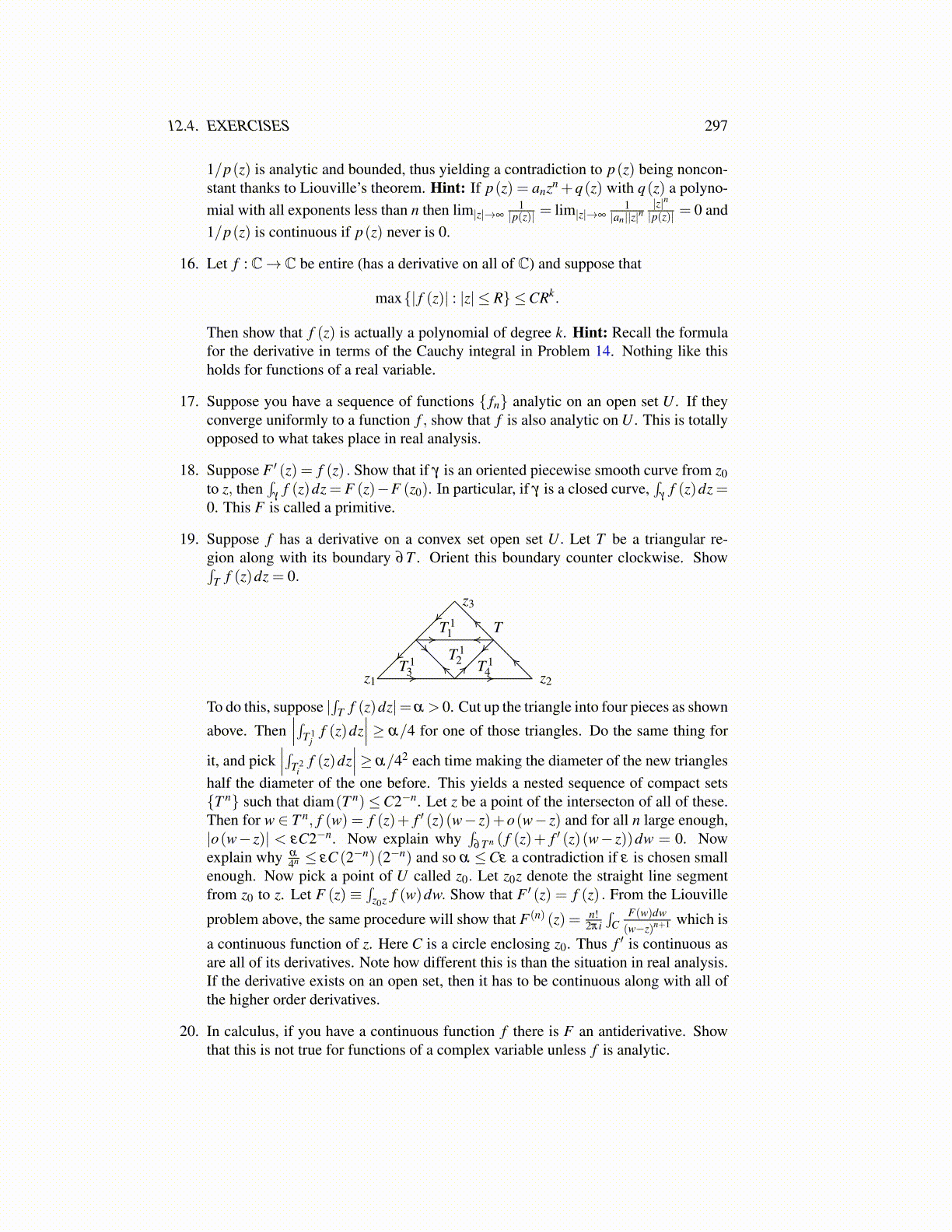
12.4. EXERCISES 297
1/p(z) is analytic and bounded, thus yielding a contradiction to p(z) being noncon-stant thanks to Liouville’s theorem. Hint: If p(z) = anzn +q(z) with q(z) a polyno-mial with all exponents less than n then lim|z|→∞
1|p(z)| = lim|z|→∞
1|an||z|n
|z|n|p(z)| = 0 and
1/p(z) is continuous if p(z) never is 0.
16. Let f : C→ C be entire (has a derivative on all of C) and suppose that
max{| f (z)| : |z| ≤ R} ≤CRk.
Then show that f (z) is actually a polynomial of degree k. Hint: Recall the formulafor the derivative in terms of the Cauchy integral in Problem 14. Nothing like thisholds for functions of a real variable.
17. Suppose you have a sequence of functions { fn} analytic on an open set U . If theyconverge uniformly to a function f , show that f is also analytic on U . This is totallyopposed to what takes place in real analysis.
18. Suppose F ′ (z) = f (z) . Show that if γ is an oriented piecewise smooth curve from z0to z, then
∫γ
f (z)dz = F (z)−F (z0). In particular, if γ is a closed curve,∫
γf (z)dz =
0. This F is called a primitive.
19. Suppose f has a derivative on a convex set open set U. Let T be a triangular re-gion along with its boundary ∂T . Orient this boundary counter clockwise. Show∫
T f (z)dz = 0.
TT 11
T 12T 1
3 T 14z1 z2
z3
To do this, suppose |∫
T f (z)dz|=α > 0. Cut up the triangle into four pieces as shown
above. Then∣∣∣∫T 1
jf (z)dz
∣∣∣ ≥ α/4 for one of those triangles. Do the same thing for
it, and pick∣∣∣∫T 2
if (z)dz
∣∣∣≥ α/42 each time making the diameter of the new triangleshalf the diameter of the one before. This yields a nested sequence of compact sets{T n} such that diam(T n)≤C2−n. Let z be a point of the intersecton of all of these.Then for w ∈ T n, f (w) = f (z)+ f ′ (z)(w− z)+o(w− z) and for all n large enough,|o(w− z)| < εC2−n. Now explain why
∫∂T n ( f (z)+ f ′ (z)(w− z))dw = 0. Now
explain why α
4n ≤ εC (2−n)(2−n) and so α ≤Cε a contradiction if ε is chosen smallenough. Now pick a point of U called z0. Let z0z denote the straight line segmentfrom z0 to z. Let F (z) ≡
∫z0z f (w)dw. Show that F ′ (z) = f (z) . From the Liouville
problem above, the same procedure will show that F(n) (z) = n!2πi∫
CF(w)dw(w−z)n+1 which is
a continuous function of z. Here C is a circle enclosing z0. Thus f ′ is continuous asare all of its derivatives. Note how different this is than the situation in real analysis.If the derivative exists on an open set, then it has to be continuous along with all ofthe higher order derivatives.
20. In calculus, if you have a continuous function f there is F an antiderivative. Showthat this is not true for functions of a complex variable unless f is analytic.